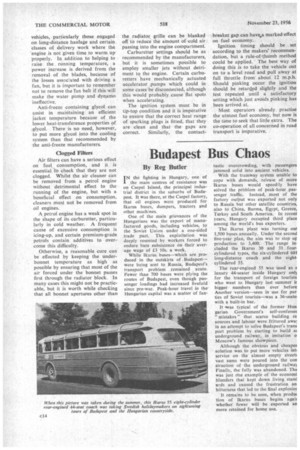Budapest Bus Chaos
Page 54

If you've noticed an error in this article please click here to report it so we can fix it.
By Reg Butler
IN the fighting in Hungary, one of I the main centres of resistance was on Csepel Island, the principal industrial district in the suburbs of Budapest. It was there, at the Csepel factory, that oil engines were produced for Ikarus buses, dumpers, tractors and other machines.
One of the main grievances of the Hungarians was the export of manufactured goods, including vehicles, to the Soviet Union under a one-sided trade pact. This exploitation was deeply resented by workers forced to endure bare subsistence on their average wage of £3 10s, a week.
While Ikarus buses—which are produced in the outskirts of. Budapest— were being sent to Russia, Budapest's transport problem remained acute. Fewer than 700 buses were plying the routes of Budapest, even though passenger loadings had increased fivefold since pre-war. Peak-hour travel in the Hungarian capital was a matter of fan
tastic overcrowding, with passengers jammed solid into ancient vehicles.
With the tramway system unable to cope with demands, release of more lkarus buses would speedily have solved the problem of peak-hour passenger traffic. Instead, most of the factory output was exported not only to Russia but other satellite countries, also to China, Burma, Egypt, Greece, Tnrkey and South America. In recent years, Hungary occupied third place among the world's bus exporters.
The Ikarus plant was turning out 1,500 buses annually. Under the second five-year plan, the aim was to step up production to 3,400. The range included the Ikarus 30 and 31 four. cylindered types, the six-cylindered 601 long-distance coach and the eightcylindered 55.
The rear-engined 55 was used as a luxury 44-seater inside Hungary onl) for the transport of foreign tourists who went to Hungary last summer is bigger numbers than ever before Another version—seen in use for par ties of Soviet tourists—was a 36-seatei with a built-in bar.
It was typical of the former Hun garian Government's self-confesse( " mistakes " that scarce building re sources and labour were frittered awal in an attempt to solve Budapest's trans port problem by starting to build at underground railway, in imitation o Moscow's famous showpiece.
Although the obvious and cheapes solution was to put more vehicles int4 service on the almost empty streets vast sums were poured into the con struction of the underground railwa) Finally, the folly was abandoned. Tha was just one example of the economi blunders that kept down living stand ards and caused the frustration an bitterness that led to the final explosior It remains to be, seen, when produc tion of Ikarus buses begins agair whether fewer will be exported an more retained for home use.
















































































































